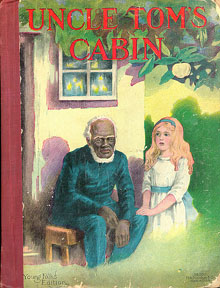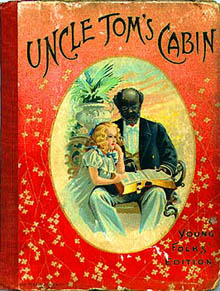  VARIANT COVER |
|
|
The Donohue company published books for children from the end of the 19th century to the middle of the 20th. Their 64-page "Young Folks' Edition" of Uncle Tom's Cabin is identified on the cover as "No. 102." The edition itself is a carelessly cobbled version of Stowe's novel. It is illustrated with 26 drawings, but little effort was made to match the illustrations to the text they appear alongside (the narrative of George Harris' fight for freedom, for example, is illustrated by two pictures of Topsy). The uncredited illustrations are the work of several artists, including Eckman and E. Thatcher, who did many of the illustrations for an unabridged Uncle Tom's Cabin in 1897. (For more details on the illustrations, see the "Gallery of Images" exhibit on this edition.) Though no adapter is credited, the text has clearly been derived from H. E. Marshall's c. 1904 UNCLE TOM'S CABIN AS TOLD TO THE CHILDREN, originally written in England and republished in the U.S. by Dutton. This text is also essentially the same as that published by Barse and Hopkins for their PLEASANT HOUR SERIES, which, though identified as the work of a woman named Mary E. Blaine, also derives from Marshall's adaptation. (Compare also to the LITTLE FOLKS' EDITION published at about the same time by Graham & Matlack.) This text minimizes the religious aspects of Tom's story. Unlike Stowe's novel, it does overtly establish the link between slaves in cotton fields and "things which we need to use and wear" (see page 54); on the other hand, its narrator refers to slaves as "niggers" three times, something Stowe never did at all (see pages 9, 21, 43), and compares Topsy to an "ugly little black doll" (page 37). Uncle Tom's Cabin: Young Folks' Edition, by Harriet Beecher Stowe COURTESY JONATHAN MURPHY. |
  VARIANT COVER |
|
